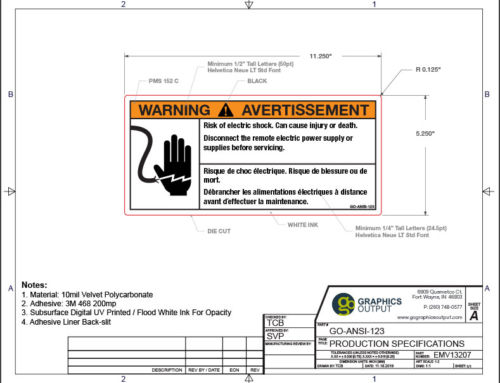Proper preparation of the application surface is key for a quality, long-lasting finished product. Labels and graphics can be applied to most clean, dry and smooth surfaces with proper preparation. Failure to follow the appropriate preparation and application procedure can cause premature decal failure.
Surface Preparation
All application surfaces should be considered contaminated and must be cleaned prior to application of the decal or graphics. A recommended procedure for cleaning is as follows:
- Saturate a clean, lint-free cloth and wipe the surface with a petroleum based cleaner (e.g. DuPont Prep-Sol #3919S Cleaner, Sherwin Williams R7 K 156 Sher-Will-Clean®, or an automotive grade cleaner and wax remover).
Avoid washing application surfaces with soaps containing creams, scents, or lotions. - Dry the surface with a lint-free cloth before the solvent evaporates from the application surface.
- Wipe the surface with isopropyl alcohol using a lint-free cloth. For the best results, use a 70% alcohol solution. Note that while higher ratio solutions are preferred, they may also damage surfaces and coatings, so use with caution.
Some surfaces may require special attention and added preparation as outlined below:
Aluminum, Badly Pitted or Oxidized Surfaces:
A commercial acid brightener solution should be used to remove/reduce oxidation (follow manufacturer’s instructions).
FRP (Fiberglass Reinforced Plywood):
Use general cleaning procedure outlined above. Gel coat cracking of the fiberglass may also cause labels to crack.
Newly Painted Surfaces:
Paint must be properly cured and decals applied over ONLY high-grade exterior coatings. Avoid finishes that tend to chalk, bleed, or contain silicone. Follow paint manufacturer’s recommendations for drying and curing. Allow surfaces to cure for at least 10 days prior to application of safety decals.
Application Over Weathered Markings:
While this is not generally recommended, use the cleaning procedure outlined above. Failure to remove old decal or graphic will reduce life of new application.
Application
The application of decals may be completed using either a dry or wet method. The wet method allows for repositioning and easier removal of wrinkles and air bubbles that can occur during application.
Dry Method
With the entire liner removed, tack decal in position with minimal thumb pressure in upper corners only. Using firm initial squeegee pressure, begin at the center of the decal and work outward from center to edge in all directions, removing all wrinkles and air pockets. Pull up initial tack points in upper corners before squeegeeing over them or wrinkling may result. Pierce any remaining air bubbles with straight pin to remove air (never use a razor blade). Re-squeegee all edges with very firm pressure to ensure complete edge seal.
Wet Method
Using a clean plastic spray bottle, mix a solution containing 12 oz. of room temperature tap water with 3-5 drops of unscented liquid dish soap (e.g. Ivory Liquid®). As the liner of the decal is removed, liberally spray the exposed adhesive with the mixed solution. The water/soap solution will allow repositioning (straightening) of the decal and act as a lubricant to aid in removing wrinkles and air bubbles. Work from the center of the decal to outside edges in all directions using plastic squeegee to remove all moisture and air. Re-squeegee to ensure removal of all water and seal decal edges. Repeat squeegee and edge seal procedure 30 minutes after application. Use a straight pin to pierce and remove any remaining air bubbles (never use a razor blade).
Recap
- Make sure application surface has been properly cleaned and prepared.
- Air and application surfaces must be above 45°F/9°C. Ideally, humidity should be below 90%.
- A firm plastic applicator/squeegee is necessary.
- A liquid soap and water solution in a spray mist bottle may be used to aid in positioning and removal of air bubbles (Wet Method).
- Use overlapping strokes when applying decals to remove all moisture and air-bubbles. This will insure complete adherence of adhesive.
- Puncture air bubbles of vinyl decals with a straight pin (never a razor blade) and press out air gently.
- Re-squeegee all edges of decal to seal final application.

The word “squeegee” is thought to have originated in 1835-45 as nautical term; of obscure origin. It is also looked at as an imitative word influence by the english word “squeeze.” Other forms of squeegee that are used are “squilgee,” and “squillagee.” All three forms can be used as a noun or a verb (used with object).
Source: American Psychological Association (APA): squeegee. (n.d.). Dictionary.com Unabridged. Retrieved June 27, 2016 from Dictionary.com




